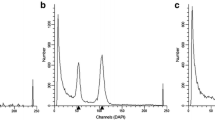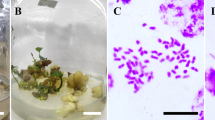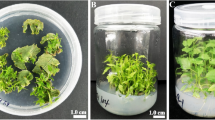Abstract
Polyploidy has played a significant role in the evolutionary history of plants and is a valuable tool for obtaining useful characteristics. Because of the novelty of polyploids, comparison of their in vitro culture responses with diploids would be notable. In this study, leaf explants from diploid, autotetraploid and mixoploid plants of Cichorium intybus L. were cultured in vitro on the similar media and under same conditions. The ploidy level of the obtained calluses and regenerants were determined by flow cytometry analysis. The callogenic response of leaf explants cultured on the callus induction medium did not depend on the ploidy level of their parental plants. According to the flow cytometry analysis, the increased ploidy levels (4x) and (8x) were observed in the callus cultures with diploid and tetraploid origin, respectively. A considerable difference was observed between the ploidy level of mixoploid plants and their calluses, indicating the dominance of diploid cells in the callus tissue. The results showed that polyploidy led to the loss of organogenic potential as the tetraploid origin calluses failed to regenerate, while the diploid origin calluses successfully regenerated to whole plants.
Similar content being viewed by others
References
Wendel, J. and Doyle, J., Polyploidy and evolution in plants, in Plant Diversity and Evolution. Genotypic and Phenotypic Variation in Higher Plants, Henry, R.J., Ed., CAB Int., 2005, pp. 97–117.
Masterson, J., Stomatal size in fossil plants: evidence for polyploidy in majority of angiosperms, Science, 1994, vol. 264, pp. 421–424.
Adams, K.L. and Wendel, J.F., Polyploidy and genome evolution in plants, Curr. Opin. Plant Biol., 2005, vol. 8, pp. 135–140.
Predieri, S., Mutation induction and tissue culture in improving fruits, Plant Cell Tissue Organ. Cult., 2001, vol. 64, pp. 185–210.
Mulabagal, V. and Tsay, H.S., Plant cell cultures an alternative and efficient source for the production of biologically important secondary metabolites, J. Appl. Sci. Eng. Tech., 2004, vol. 2, pp. 29–48.
Palomino, G., Dolezel, J., Cid, R., et al., Nuclear genome stability of Mammillaria san-angelensis (Cactaceae) regenerants induced by auxins in long-term in vitro culture, Plant Sci., 1999, vol. 141, pp. 191–200.
Mishiba, K., Okamoto, T., and Mii, M., Increasing ploidy level in cell suspension cultures of Doritaenopsis by exogenous application of 2,4-dichlorophenoxyacetic acid, Physiol. Plant., 2001, vol. 112, pp. 142–148.
Nontaswatsri, C. and Fukai, S., Regenerative callus of dianthus “Telstar Scarlet” showing mixoploidy produce diploid plants, Plant Cell Tussue Organ. Cult., 2005, vol. 83, pp. 351–355.
Fras, A. and Maluszynska, J., The correlation between the chromosome variation in callus and genotype of explants of Arabidopsis thaliana, Genetics, 2004, vol. 121, pp. 145–154.
Karp, A., The origins and causes of chromosome instability in plant, in Kew Chromosome Conference III, Brandham, P.E., Ed., London, 1988, pp. 185–192.
Ono, Y., Takahata, Y., and Kaizuma, N., Effect of genotype on shoot regeneration from cotyledonary explants of rapeseed (Brassica napus), Plant Cell Rep., 1994, vol. 14, pp. 13–17.
Garcia, E. and Martinez, S., Somatic embryogenesis in Solanum tuberosum L. cv. Desiree from stem nodal sections, J. Plant Physiol., 1995, vol. 145, pp. 526–530.
Profumo, P., Gastaldo, P., Caffaro, L., et al., Callus induction and plantlet regeneration in Cirhorium intybus L.: 2. Effect of different hormonal treatments, Protoplasma, 1985, vol. 126, pp. 215–220.
Pieron, S., Belaizi, M., and Boxus, P., Nodule culture, a possible morphogenetic pathway in Cichorium intybus L. propagation, Sci. Hort., 1993, vol. 53, pp. 1–11.
Vesseur, J., Dubois, J., Hilbert, J.L., and Couillerot, J.P., in Biotechnology and Agricultural Forestry: Somatic Embryogenesis and Synthetic Seeds II, Bojaj, Y.P.S., Ed., Berlin: Springer, 1995, pp. 125–137.
Belletre, A., Coullerot, J.P., and Vasseur, J., Effects of glycerol on somatic embryogenesis in Cichorium leaves, Plant Cell Rep., 1999, vol. 19, pp. 26–31.
Rehman, R.U., Israr, M., Srivastava, P.S., et al., In vitro regeneration of witloof chicory (Cichorium intybus L.) from leaf explants and accumulation of esculin, In Vitro Cell Dev. Biol. Plant, 2003, vol. 39, pp. 142–146.
Bennici, A., Schiff, S., and Mori, B., Morphogenic effect of colchicine in Cichorium intybus L. root explants cultured in vitro, Caryologia, 2006, vol. 59, pp. 284–290.
Velayutham, P., Ranjithakumari, B.D., and Baskaran, P., An efficient in vitro plant regeneration system for Cichorium intybus L.—an important medicinal plant, J. Agric. Technol., 2007, vol. 2, no. 2, pp. 287–298.
Ghotbi, Ravandi, E., Rezanejad, F., Zolala, J., and Dehghan, E., The effects of chromosome-doubling on selected morphological and phytochemical characteristics of Cichorium intybus L., J. Hor. Sci. Biotech., 2013, vol. 88, pp. 701–709.
Sengupta, J., Mitra, G.C., and Sharma, A.K., Study of chromosomes in two callus lines and in regenerated plants of Kallstroemia pubescens (G. Don) Dandy, Cotylogia, 1987, vol. 52, pp. 767–770.
Maluszynska, J., B chromosomes of Crepid capillaries (L.) Waller. in vivo and in vitro, Pr. Nauk. Uniw. Slask. Katowicach, 1990.
Wyman, J., Brassard, N., Flipo, D., and Lalibert, S., Ploidy level stability of callus tissue, axillary and adventitious shoots of Larix eurolepis Henry regenerated in vitro, Plant Sci., 1992, vol. 85, pp. 189–196.
Ezura, H. and Oosawa, K., Selective regeneration of plants from diploid and tetraploid cells in adventitious shoot cultures of melon Cucumis melo L., Plant Tissue Cult. Lett., 1994, vol. 11, no. 1, pp. 26–33.
Fras, A. and Poliploidalnos, C.W., Kulturze in vitro Arabidopsis thaliana, Ph.D. Dissertation, Katowice: Univ. Silesia, 2001.
Nilanthi, D., Chen, X., Zhao, F., et al., Induction of tetraploids from petiole explants through colchicine treatments in Echinacea purpurea L., J. Biomed. Biotechnol., 2009, Article ID343485.
Tai, W., Multipolar meiosis in diploid crested wheatgrass Agropyrum cristatum, Am. J. Bot., 1970, vol. 57, pp. 1160–1169.
Risso-Pascotto, C., Pagliarini, M.S., and Do, ValleC.B., Multiple spindles and cellularization during microsporogenesis in an artificially induced tetraploid accession of Brachiaria ruziziensis (Gramineae), Plant Cell Rep., 2005, vol. 23, pp. 522–527.
Kubalakova, M., Dolezel, J., and Lebeda, A., Ploidy instability of embryogenic cucumber (Cucumis sativus L.) callus culture, Biol. Plant., 1996, vol. 38, no. 3, pp. 475–480.
Sun, Q., Sun, H., Bell, R.L., et al., Variation of phenotype, ploidy level and organogenic potential of in vitro regenerated polyploids of Pyrus communis, Plant Cell Tissue Organ. Cult., 2011, vol. 107, pp. 131–140.
Comai, L., The advantages and disadvantages of being polyploidy, Nat. Rev. Genet., 2005, vol. 6, pp. 836–846.
Compton, M.E. and Preece, J.E., Exudation and explant establishment, IAPTC Newslett., 1986, vol. 50, pp. 9–18.
Laukkanen, H., Haggman, H., Kontunen-Soppela, S., and Hohtola, A., Tissue browning of in vitro cultures of Scots pine: role of peroxidase and polyphenol oxidase, Physiol. Plant., 1999, vol. 106, pp. 337–343.
Arnaldos, T.L., Munoz, R., Ferrer, M.A., and Calderon, A.A., Changes in phenol content during strawberry (Fragaria ananasa, cv. chandler) callus culture, Physiol. Plant., 2001, vol. 113, pp. 315–322.
Jacq, B., Tetu, T., Sangwan, R.S., et al., Plant regeneration from sugarbeet (Beta vulgaris L.) hypocotyls cultures in vitro and flow cytometric nuclear DNA analysis of regenerants, Plant Cell Rep., 1992, vol. 11, pp. 329–333.
Kasperek, G., Artificial polyploids of the pea, Pisum Newslett., 1986, vol. 18, p. 32.
Gottschalk, W., Tetraploidy following X-radiation, Pisum Newslett., 1988, vol. 20, pp. 14–15.
Author information
Authors and Affiliations
Corresponding author
Additional information
The article is published in the original.
About this article
Cite this article
Ghotbi Ravandi, E., Rezanejad, F. & Dehghan, E. In vitro regeneration ability of diploid and autotetraploid plants of Cichorium intybus L.. Cytol. Genet. 48, 166–170 (2014). https://doi.org/10.3103/S0095452714030050
Received:
Published:
Issue Date:
DOI: https://doi.org/10.3103/S0095452714030050




